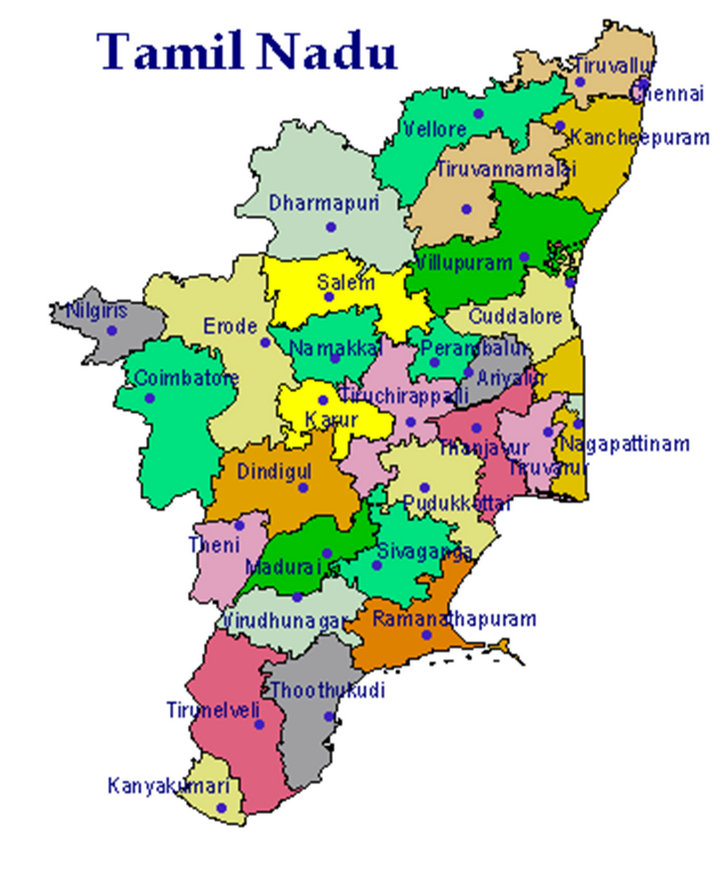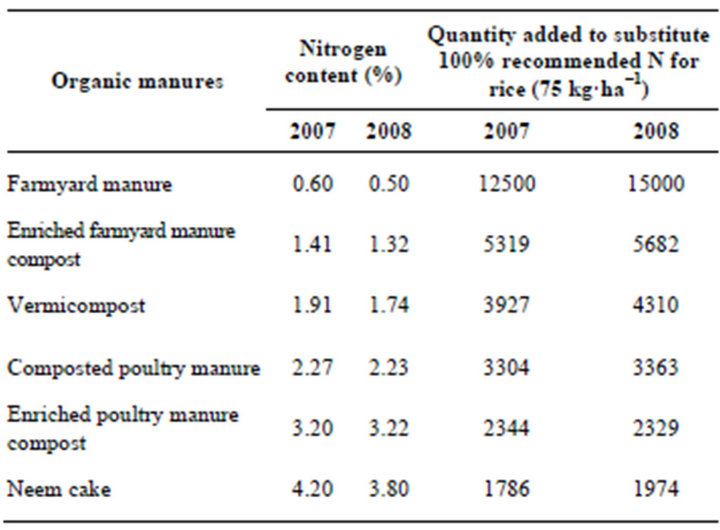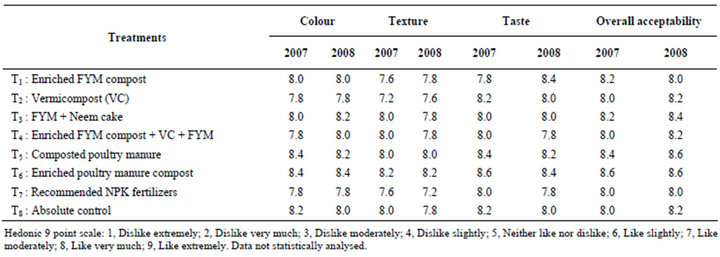American Journal of Plant Sciences
Vol.4 No.5(2013), Article ID:32168,7 pages DOI:10.4236/ajps.2013.45141
Influence of Organic Manures on Yield and Quality of Rice (Oryza sativa L.) and Blackgram (Vigna mungo L.) in Rice-Blackgram Cropping Sequence
![]()
Department of Agronomy, Tamil Nadu Agricultural University, Coimbatore, India.
Email: *sangeetha.agr@gmail.com
Copyright © 2013 S. P. Sangeetha et al. This is an open access article distributed under the Creative Commons Attribution License, which permits unrestricted use, distribution, and reproduction in any medium, provided the original work is properly cited.
Received March 12th, 2013; revised April 15th, 2013; accepted May 1st, 2013
Keywords: Organic Manures; Rice-Blackgram Cropping; Yield; Quality
ABSTRACT
Field experiments were conducted at Tamil Nadu Agricultural University, Coimbatore during rabi and summer seasons of 2007-2008 and 2008-2009 to study the influence of organic manures (enriched farmyard manure compost, vermicompost, farmyard manure + neem cake, enriched farmyard manure compost + vermicompost + farmyard manure, composted poultry manure and enriched poultry manure compost) and recommended NPK fertilizers on yield and quality of rice and blackgram in rice-blackgram cropping sequence. Based on field experiments, it was found that the application of enriched poultry manure compost on equal N basis (2.3 t·ha−1) recorded higher yield attributes and grain yield of rice (4675 kg·ha−1 in 2007 and 4953 kg·ha−1 in 2008), which was however comparable with composted poultry manure. The application of recommended NPK fertilizers recorded higher physical characteristics and cooking qualities of rice, which was comparable with enriched poultry manure compost. Higher sensory score was registered in enriched poultry manure compost as compared to recommended NPK through fertilizers. After harvesting of rice, the residual effect of enriched poultry manure compost and composted poultry manure applied to preceding rice crop improved yield attributes and yield of succeeding blackgram.
1. Introduction
Rice (Oryza sativa L.) is the most important and extensively cultivated food crop, which provides half the daily food for one of every three persons on the earth. In Asia alone, more than two billion people obtain 60 to 70 per cent of their energy intake from rice and its derivatives. Rice-rice-pulse (Greengram/Blackgram) is the predominant cropping system of major rice growing areas of Tamil Nadu. The cropping sequence of rice-pulse is practically feasible, viable, economical, eco-friendly, water saving technology for sustaining soil fertility and rice productivity. Increased use of inorganic fertilizers in crop production deteriorates soil health, causes health hazard and insecurity of quality food. Energy crisis, higher fertilizer cost, sustainability in agri-production system and ecological stability are the important issues which renewed the interest of farmers and research workers in non-chemical sources of plant nutrients like biofertilizers, farmyard manure, green manure, composts etc. Awareness about crop quality and soil health increased the attention of people towards organic farming [1]. Balanced use of nutrients through organic sources like farmyard manure, vermicompost, green manuring, neem cake and biofertilizers are prerequisites to sustain soil fertility, to produce maximum crop yield with optimum input level [2]. The organic manures leave behind sufficient residual effect for the sequence crops [3]. In view of the above facts, field experiment on “Influence of organic manures on yield and quality of rice and blackgram in rice-blackgram cropping sequence” was conducted with the following objectives.
1) To study the influence of different sources of organic manures on yield of rice and their residual effect on succeeding blackgram;
2) To know the effect of organic manuring on quality of rice grain.
2. Materials and Methods
2.1. Experimental Site and Initial Soil Characteristics
Field experiments were conducted during rabi and summer seasons of 2007-2008 and 2008-2009 at wetland, Tamil Nadu Agricultural University, Coimbatore located at Western Agro-climatic Zone of Tamil Nadu at 11˚ North latitude and 77˚ East longitude with an altitude of 426.7 m above MSL (Figure 1). The soil of the experimental field was clay loam in texture having a slightly alkaline pH of 8.1 with low soluble salts (EC = 0.45 dS·m−1), medium organic carbon content (0.52 per cent), low in available nitrogen (262 kg·ha−1), medium in available phosphorus (18.2 kg·ha−1) and high in available potassium (576 kg·ha−1).
2.2. Experimental Design, Treatment Details and Selection of Cultivar
The field experiment was laid out in randomized block design with three replications. The experiment consisted of eight treatments viz., enriched farmyard manure compost, vermicompost, farmyard manure + neem cake (1/2 + 1/2), enriched farmyard manure compost + vermicompost + farmyard manure (1/3 + 1/3 + 1/3), composted poultry manure, enriched poultry manure compost, recommended NPK fertilizer and absolute control (without organic and inorganic). Based on the equal N basis, required quantities of organic manures were incorporated in the soil two weeks before transplanting of rice. In

Figure 1. Field Location.
recommended NPK fertilizer treatment, recommended doses of 75:50:50 kg·ha−1 of N, P and K in the form of urea (46% N), single super phosphate (16% P2O5) and muriate of potash (60% K2O) were applied to the rice crop. The N was applied in four equal splits at basal, active tillering, panicle initiation and flowering stages. The entire dose of P and K was applied basally before sowing. The consumer preference rice variety, improved white ponni was raised. Transplanting was done in the main field with a spacing of 20 × 10 cm at two seedlings hill−1. After harvesting of rice, the residual crop of blackgram T9 variety was sown in the same plots with a spacing of 30 × 10 cm. No organic manures and inorganic fertilizer was applied to the black gram. Other management practices were adopted as per recommendation of the crops.
2.3. Enriched Organic Manure Preparation
The enriched farmyard manure compost was prepared by using 10 kg of rock phosphate and 10 kg of each biofertilizers viz., Azospirillum, Azotobacter and Phosphobacteria were thoroughly mixed with 1000 kg of decomposed and powdered farmyard manure on dry weight basis and made into a heap like structure. The heap was kept for 60 days for composting under the shade with 60% moisture. For enriched poultry manure compost, 20 kg of rock phosphate and 10 kg of each biofertilizers viz., Azospirillum, Azotobacter and Phosphobacteria were thoroughly mixed with 1000 kg of poultry manure on dry weight basis and made into a heap like structure. The heap was kept for 60 days for composting under the shade with 60% moisture [4]. The manurial value of organic manures was analysed and quantity required for the experiment was worked out based on equal N basis (Table 1).
2.4. Biometric and Yield Observations
Five plants in each plot were selected at random and tagged. These plants were used for recording biometric observation at different stages of crop growth. The harvested produce from each net plot was threshed, sun dried, winnowed separately and the grain yield was recorded at 14 per cent moisture content and expressed in kg·ha−1. The straw yield of rice was recorded from the net plot area after enough sun drying and expressed in kg·ha−1.
2.5. Rice grain Quality Analysis
The rough rice (paddy) was cleaned, dried to 12 to 14 per cent moisture and dehulled with a McGill laboratory sheller. After hulling, the brown rice was milled and polished in a Kett polisher for a standard time to find out the milling percentage and head rice recovery.

Table 1. Nitrogen content of organic manures on dry weight basis.
Milling recovery (%) = 
Head rice recovery (%) = 
Broken rice percentage is defined as the percentage of broken rice to the weight of total quantity of rice obtained by shelling.
Broken rice (%) = [W2 (W1+W2)] × 100 where, W1: Weight of whole rice in the sample (g); W2: Weight of broken rice in the sample (g).
The rice grain length was estimated by ten rice grains of uniform size were kept length-wise on a graph paper and the mean length was measured and expressed in mm. The rice grain breadth was estimated ten rice grains of uniform size were kept breadth-wise on a graph paper and the mean breadth was measured and expressed in mm. The volume expansion ratio is the ratio between the cooked volume to the uncooked. Five gram of rice was added in a boiling test tube and the level was marked. It was cooked by adding water and the level of rice was also marked. The volume was measured by using water displacement method. The water absorption ratio is the ratio between the weight of the cooked rice to the uncooked [5]. Ten normal milled grains are presoaked to 10 - 30 minutes and placed directly into boiling water either by direct dropping or in a wire cage or basket until its optimum cooking time. The length and breadth of cooked rice are measured and the length breadth ratio after cooking (LBAC) was worked out.
LBAC = 
Plain cooked rice was evaluated by a trained panel of judges for their sensory attributes consisting of colour, texture, taste and overall acceptability using a score card with nine point Hedonic scale [6].
2.6. Statistical Analysis
The data on various characters studied during the course of investigation were statistically analysed [7] for randomized block design. Wherever treatment differences were significant (“F” test), critical differences were worked out at five per cent probability level. Treatment differences that were not significant were denoted as “NS”.
3. Results and Discussion
3.1. Influence of Organic Manures on Rice
During both the years of field trial, yield attributing characters viz., productive tillers m−2, filled spikelets panicle- 1 and grain and straw yield of rice were influenced significantly by the application of organic manures and recommended NPK through fertilizer (Table 2). Application of enriched poultry manure compost recorded increased number of productive tillers m−2 and filled spikelets panicle−1 and it was comparable with composted poultry manure. These were followed by recommended NPK fertilizer. The enriched poultry manure compost increased productive tillers (35.8 and 36.3 per cent) and filled spikelets panicle−1 (54.6 and 65.6 per cent) than absolute control during rabi 2007 and 2008, respectively. This might be due to higher concentration of macro and micronutrients in the enriched poultry manure compost and composted poultry manure and higher and steady nutrient release compared to other organic manures. Further, the poultry waste had both urinary and fecal excretion, hence the fertilizer value was nearly three times higher than farmyard manure [8]. The enhanced and continuous supply of nutrients by the enriched organics lead to better tiller production and filled grain of rice [9].
The application of enriched poultry manure compost recorded higher grain yield (4675 and 4953 kg·ha−1 in 2007 and 2008, respectively), which was found to be on par with composted poultry manure. These were fol- lowed by recommended NPK fertilizer, which was however comparable with composted poultry manure in both the years. Lower grain yield was recorded in absolute control during both the years. The supremacy of enriched poultry manure compost lies in the fact that it can supply the nutrients in soluble form for a quite longer period by not allowing the entire soluble form into solution, to come in contact with soil and other inorganic constituents, thereby minimizing fixation and precipitation from the enriched manures, the plant roots can very well compete with loss mechanisms and absorb more nutrients leading to better yield [9].
3.2. Residual Effects of Organic Manures on Blackgram
The yield attributes (number of cluster plant−1, number of pods plant−1 and number of seeds pod−1), grain and haulm yields of blackgram was markedly increased due to the residual effect of application of organic manures to preceding rice crop than recommended NPK fertilizer and absolute control (Table 3). Grain yield was higher (507 kg·ha−1 during summer 2008 and 514 kg·ha−1 during summer 2009) in the residual effect of enriched poultry manure compost and which was comparable with composted poultry manure and farmyard manure + neem cake. The enriched poultry manure compost increased grain yield by 42.8 per cent during summer 2008 and 47.7 per cent during summer 2009 over absolute control. The superiority of residual effect of enriched poultry manure compost and composted poultry manure was attributed to its slow decomposition, which probably released the nutrients slowly as compared to other organic materials [10].

Table 2. Yield attributes and yield of rice as influenced by organic manures and fertilizers.

Table 3. Residual effect of organic manures and fertilizers on yield attributes and yields of succeeding blackgram.

Table 4. Milling characteristics of paddy and physical characteristics of raw rice grain.

Table 5. Effect of organic manures on cooking qualities of milled rice (open cooked).

Table 6. Mean scores for selected sensory characteristics of cooked rice (open cooked).
3.3. Influence of Organic Manures on Rice Quality
3.3.1. Milling and Physical Characteristics of Paddy and Raw Rice Grain
The recommended NPK fertilizer recorded higher milling recovery, head rice per cent and lower broken percentage of rice and which was comparable with enriched poultry manure compost and composted poultry manure. The absolute control had shown lower milling recovery, head rice percentage and higher broken rice percentage (Table 4). This might be due to better amenability for shelling, good grain size and less number of chalky grains was observed under recommended NPK fertilizer application. Though N was supplied on equivalent N basis, the enriched poultry manure compost contains more P, K and micronutrients which might have helped to reduce broken percentage and in turn increased head rice recovery. Grain length and breadth were maximum in recommended NPK fertilizer and it was on par with enriched poultry manure compost, composted poultry manure and farmyard manure + neem cake. Application of poultry manure resulted to better physical characteristics of grain [11].
3.3.2. Cooking Qualities of Milled Rice
The recommended NPK fertilizer and enriched poultry manure compost had higher volume expansion ratio and improved water absorption ratio. Bold rice grain was observed in these treatments might be the reason for the higher volume expansion and water absorption ratio [12]. The increased length breadth ratio after cooking was observed in enriched farmyard manure compost and composted poultry manure, vermicompost and farmyard manure + neem cake (Table 5). This character is considered as desirable trait in high quality rice. The application of organic manures gave a higher L: B ratio of rice after cooking than with inorganic fertilizer [13]. The lesser LBAC was registered in recommended NPK fertilizer and absolute control.
3.3.3. Sensory Characteristics of Cooked rice
The enriched poultry manure compost registered higher colour, texture, taste and overall acceptability score as compared to recommended NPK fertilizer (Table 6). Similarly, the quality characteristics of rice were improved with application of poultry manure [14]. The eating quality of rice was higher under organic farming than conventional farming and improved organoleptic properties was observed in organically produced food [15].
From the present investigation, it could be concluded that the application of enriched poultry manure compost on equal N basis (2.3 t·ha−1) recorded higher yield attributes and grain yield of rice, which was however comparable with composted poultry manure. The residual effect of enriched poultry manure compost and composted poultry manure applied to preceding rice crop improved yield attributes and yield of succeeding blackgram. Improved rice grain quality, in terms of chemical composition, cooking quality and high score of sensory evaluation was achieved under organic manures application.
REFERENCES
- M. Sharma, C. S. Pandey and B. S. Mahapatra, “Effect of Biofertilizers on Yield and Nutrient Uptake by Rice and Wheat in Rice-Wheat Cropping System under Organic Mode of Cultivation,” Journal of Eco-friendly Agriculture, Vol. 3, No. 1, 2008, pp. 19-23.
- A. V. Dahiphale, D. G. Giri, G. V. Thakre and M. D. Gin, “Effect of Integrated Nutrient Management on Yield and Yield Contributing Parameters of the Scented Rice,” Annals of Plant Physiology, Vol. 17, No. 1, 2003, pp. 24-26.
- A. Singh, R. D. Singh and R. P. Awasthi, “Organic Andinorganic Sources of Fertilizers for Sustained Productivity in Rice (Oryza sativa)-wheat (Triticum aestivum) Sequences on Humid Hilly Soils of Sikkim,” Indian Journal of Agronomy, Vol. 41, No. 2, 1996, pp. 191-194.
- T. T. Sims, D. W. Murphy and T. S. Handweker, “Composting of Poultry Wastes: Implication for Dead Poultry Disposal and Manure Management,” Journal of Sustainable Agriculture, Vol. 2, No. 4, 1992, pp. 67-82. doi:10.1300/J064v02n04_07
- M. S. Khan and C. A. Ali, “Cooking Qualities of Some Rice Varieties,” Journal of Agriculture Research, Vol. 23, No. 3, 1985, pp. 231-233.
- B. M. Watts, G. L. Jlimaki, L. E. Jeffery and L. G. Elias, “Basic Sensory Methods for Food Evaluation,” International Development Research Centre (IDRC), Ottawa, 1989, pp. 1-16.
- K. A. Gomez and A. A. Gomez, “Statistical Procedures for Agricultural Research,” John Wiley and Sons, New Delhi, 1984, p. 680.
- G. Devegowda, “Poultry Manure Excreta and Other Wastes as a Source of Organic Manures,” In: Training Course on Organic Farming, UAS, GKVK, Bangalore, 1997, pp. 7-11.
- S. Mohandas, V. Paramasivam and N. Sakthivel, “Phosphorus and Zinc Enriched Organics for Enhancing the Yield of Transplanted Rice in New Cauvery Delta, Tamil Nadu,” Journal of Ecobiology, Vol. 23, No. 3, 2008, pp. 73-76.
- R. S. Seshadri, B. Shivaraj, V. C. Reddy and M. G. Ananda, “Direct Effect of Fertilizers and Residual Effect of Organic Manures on Yield and Nutrient Uptake of Maize (Zea mays L.) in Groundnut-Maize Cropping System,” Crop Research, Vol. 29, No. 3, 2005, pp. 390-395.
- A. Kenchaiah, “Organic Farming in Rice,” Ph.D. Thesis, Tamil Nadu Agricultural University, Coimbatore, 1997.
- B. K. Yadav and A. C. Lourduraj, “Effect of Organic Manures and Panchagavya Spray on Yield Attributes, Yield and Economics of Rice (Oryza sativa L.),” Crop Research, Vol. 31, No. 1, 2006, pp. 1-5.
- Nguyen, Van Quyen, S. N. Sharma and R. C. Gautam, “Comparative Study of Organic and Traditional Farming for Sustainable Rice Production,” Omonrice, Vol. 10, 2002, pp. 74-78.
- S. C. Hsieh, “Technology for Sustainable Agriculture in Taiwan, Sustainable Food Production in the Asian and Specific Region,” FFTC Book Series No. 48, pp. 15-21.
- P. Senthil Kumaran and V. Vadivel, “Organic Farming for Sustainable Agriculture,” Spice India, 2001, pp. 2-4.
NOTES
*Corresponding author.

